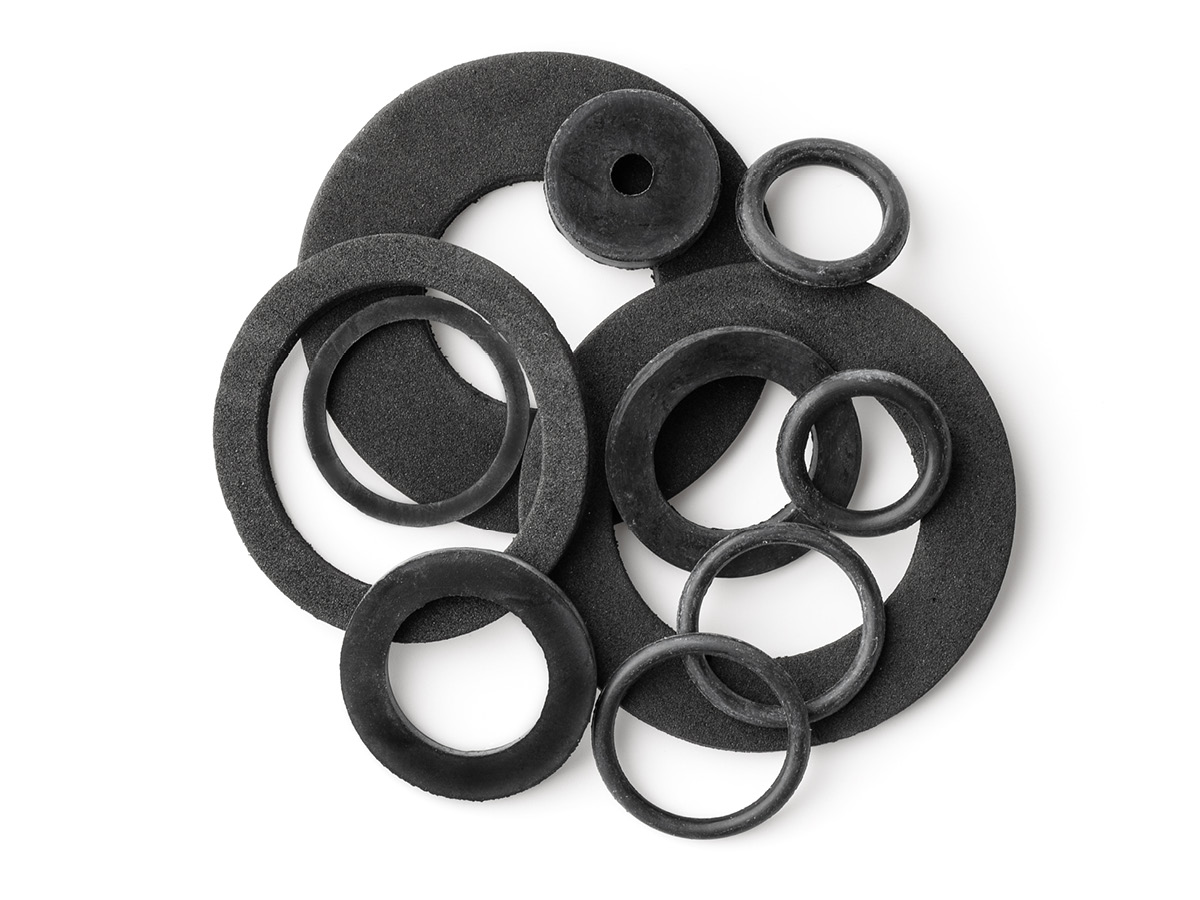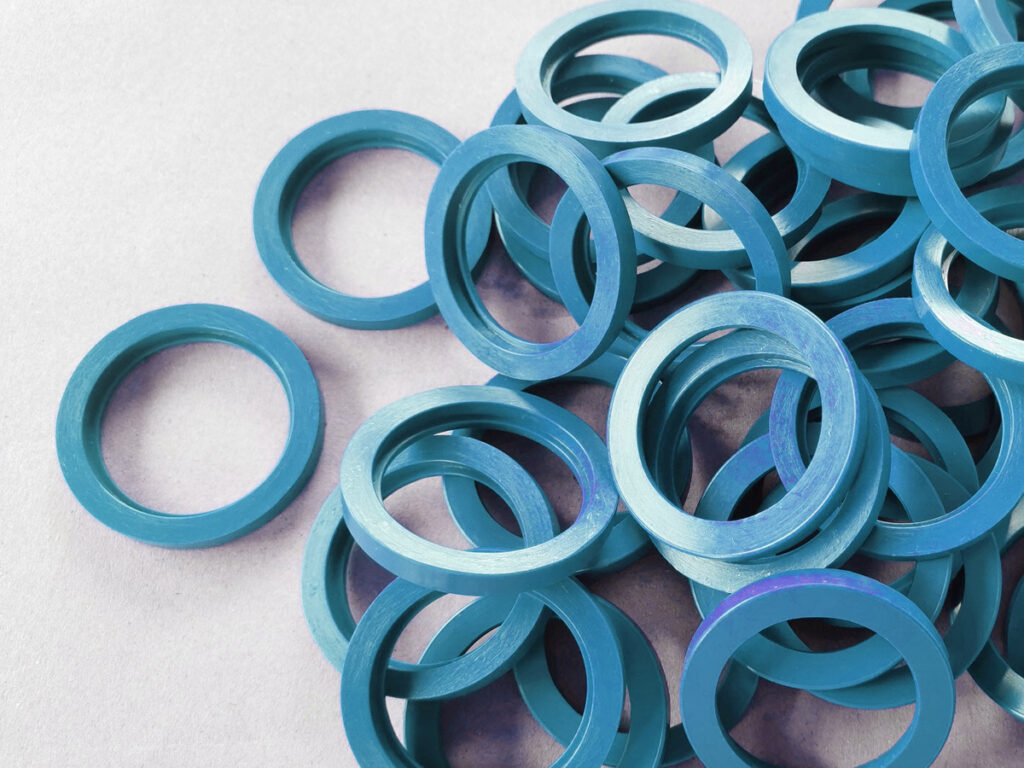Metal-Detectable O-Rings FAQs
Welcome to our FAQ on metal-detectable o-rings! These specialized sealing components are crucial for ensuring product safety and compliance in various industries. Here, you’ll find concise answers to common questions about metal-detectable o-rings, helping you understand their benefits, applications, and specifications.
What are metal-detectable o-rings?
Metal-detectable o-rings are specially designed sealing components used in the food, beverage, and pharmaceutical industries. They contain metal additives, making them easily detectable by metal detectors to prevent contamination. If the o-ring begins to degrade, it can be quickly identified and removed from the production line, ensuring product safety and quality. These o-rings offer the same reliable sealing properties as standard o-rings while enhancing safety and compliance.
What industries use metal-detectable o-rings?
Metal-detectable o-rings are primarily used in the food, beverage, and pharmaceutical industries. These industries require stringent contamination control to ensure product safety and quality. Metal-detectable o-rings help prevent contamination by being easily identified by metal detectors if they break or become loose during production. Adhering to regulations such as Title 21 CFR 177.2600 can be easier through the use of metal-detectable o-rings.
What materials are used in metal-detectable o-rings?
Metal-detectable o-rings are typically made from elastomeric materials that have been infused with metal additives or particles to make them detectable by metal detectors. Common materials used include:
- Nitrile Rubber (NBR): Known for its good resistance to oils and chemicals.
- Silicone (VMQ): Offers excellent temperature resistance and flexibility.
- EPDM (Ethylene Propylene Diene Monomer): Suitable for use with water, steam, and some chemicals.
- FKM (Viton®): Provides high resistance to heat, chemicals, and oils.
These materials are combined with metal powders or compounds to ensure that even small fragments of the o-ring can be detected by standard metal detection systems used in food, beverage, and pharmaceutical processing.
Can metal-detectable o-rings be detected by standard metal detectors used in food processing facilities?
Yes, metal-detectable o-rings can be detected by standard metal detectors used in food processing facilities.
Are Marco Rubber’s metal-detectable o-rings FDA-compliant?
Yes, our metal-detectable o-rings at Marco Rubber are FDA-compliant. We ensure that the materials used in our o-rings meet the stringent requirements set by the FDA for food contact applications. This compliance guarantees that our products are safe and suitable for use in the food processing, beverage, and pharmaceutical industries, where preventing contamination is critical. You can trust our metal-detectable o-rings to help maintain the highest standard of product safety and quality.
What industries benefit the most from using metal-detectable o-rings?
At Marco Rubber, we see the greatest benefits of metal-detectable o-rings in the following industries:
- Food Processing: Ensuring product safety by preventing contamination and meeting strict regulatory standards.
- Beverage Production: Safeguarding against contamination in liquids and maintaining high-quality standards.
- Pharmaceutical Manufacturing: Ensuring the purity and safety of medical products by preventing foreign material contamination.
These industries benefit from enhanced safety, compliance with regulatory requirements, and minimized risk of product recalls, making metal-detectable o-rings an essential component in their production processes.
What sizes and specifications are available for metal-detectable o-rings?
At Marco Rubber, our metal-detectable o-rings come in a wide range of standard sizes and specifications. Here are some key details:
- Sizes: We offer standard sizes that conform to AS568, ISO 3601, and other international standards. Custom sizes are also available to fit specific applications.
- Materials: Our metal-detectable o-rings are made from high-quality elastomers such as:
- Nitrile Rubber (NBR)
- Silicone (VMQ)
- EPDM (Ethylene Propylene Diene Monomer)
- FKM (Viton®)
- Hardness: Available in various durometers (hardness levels) to suit different sealing requirements, typically ranging from 40 to 90 Shore A.
- Temperature Range: Our o-rings can operate effectively in a broad temperature range, depending on the material:
- Nitrile: -40°F to 250°F (-40°C to 121°C)
- Silicone: -75°F to 450°F (-59°C to 232°C)
- EPDM: -70°F to 300°F (-57°C to 149°C)
- FKM: -15°F to 400°F (-26°C to 204°C)
- Compliance: All our metal-detectable o-rings are FDA-compliant and suitable for food, beverage, and pharmaceutical applications.
- Customization: We can tailor o-rings to specific requirements, including size, material, and detection capabilities.
For more detailed specifications or to find the perfect metal-detectable o-ring for your application, please contact our experts.
Can metal-detectable o-rings be customized?
Yes, at Marco Rubber, metal-detectable o-rings can be customized to meet your specific requirements. Customization options include:
- Size: Custom sizes to fit unique applications beyond standard dimensions.
- Material: Selection from various elastomers like Nitrile (NBR), Silicone (VMQ), EPDM, and FKM (Viton®) to suit different environmental conditions and chemical exposures.
- Hardness: Different durometer (hardness) levels to ensure the right balance of flexibility and durability for your application.
- Color: Custom colors to enhance visibility and aid in rapid identification during inspections.
- Temperature and Chemical Resistance: Tailoring materials to withstand specific temperature ranges and chemical exposures.
How do I choose the right metal-detectable o-ring for my application?
Choosing a metal-detectable o-ring follows the same process as other o-rings. Learn the process here.
What is the temperature range for metal-detectable o-rings?
The temperature range for metal-detectable o-rings varies depending on the material used. Here are the typical temperature ranges for common elastomers used in metal-detectable o-rings:
- Nitrile Rubber (NBR): -40°F to 250°F (-40°C to 121°C)
- Silicone (VMQ): -75°F to 450°F (-59°C to 232°C)
- EPDM (Ethylene Propylene Diene Monomer): -70°F to 300°F (-57°C to 149°C)
- FKM (Viton®): -15°F to 400°F (-26°C to 204°C)
These ranges ensure that metal-detectable o-rings can operate effectively under various environmental conditions. When selecting an o-ring for your application, consider the specific temperature requirements to ensure optimal performance and longevity.
How durable are metal-detectable o-rings compared to standard o-rings?
Metal-detectable o-rings are as durable as standard o-rings. Made from high-quality elastomers like Nitrile, Silicone, EPDM, and FKM (Viton®), they offer comparable temperature and chemical resistance, tensile strength, and elasticity. The addition of metal particles enhances safety without compromising durability, making them ideal for food, beverage, pharmaceutical, and other industrial applications.
What is the detection sensitivity of Marco Rubber’s metal-detectable o-rings?
Marco Rubber’s metal-detectable o-rings are designed to be easily detected by standard metal detection systems used in the food, beverage, and pharmaceutical industries. The detection sensitivity depends on the specific detection equipment and settings, but our o-rings typically contain sufficient metal content to ensure they are quickly identified if broken or lost during production, enhancing safety and contamination control. For precise detection sensitivity, please refer to your metal detector’s specifications and consult with our team for compatibility.
Are there any special installation or maintenance requirements for metal-detectable o-rings?
Metal-detectable o-rings do not require special installation or maintenance compared to standard o-rings. However, to ensure optimal performance and longevity, follow these best practices:
- Installation:
- Clean Surfaces: Ensure all mating surfaces are clean and free of debris.
- Lubrication: Use a compatible lubricant to reduce friction and prevent damage during installation.
- Avoid Stretching: Stretch the o-ring only as much as necessary to fit over components.
- Proper Tools: Use appropriate tools to avoid cutting or nicking the o-ring.
- Maintenance:
- Regular Inspections: Periodically check for signs of wear, damage, or degradation.
- Replace When Necessary: Replace o-rings at the first sign of damage to maintain sealing integrity and detectability.
- Clean Regularly: Keep o-rings and surrounding areas clean to prevent contamination.
Following these guidelines will help maintain the performance and safety benefits of your metal-detectable o-rings.
How often should metal-detectable o-rings be inspected or replaced?
Metal-detectable o-rings should be inspected regularly and replaced as needed to ensure optimal performance and safety. Here’s a simple guideline:
- Inspection Frequency:
- Monthly Checks: Inspect the o-rings at least once a month.
- High-Wear Applications: Increase inspection frequency if the o-rings are used in high-wear or critical applications.
- Replacement:
- Signs of Damage: Replace o-rings immediately if you notice any signs of wear, cracking, abrasion, or deformation.
- Preventive Replacement: Establish a preventive maintenance schedule, replacing o-rings at regular intervals based on your specific operating conditions, even if no visible damage is present.
Regular inspection and timely replacement will help ensure the effectiveness and safety of your metal-detectable o-rings, minimizing the risk of contamination and equipment failure.
Can metal-detectable o-rings be used in both wet and dry environments?
Yes, metal-detectable o-rings can be used in both wet and dry environments. They are designed to perform reliably under various conditions, making them versatile for different applications. The key is to select the appropriate material based on the specific environmental conditions:
- Wet Environments:
- EPDM: Excellent for water and steam applications.
- Silicone: Good for a wide range of temperatures and compatible with many aqueous solutions.
- FKM (Viton®): Resistant to many chemicals and suitable for high-temperature applications.
- Dry Environments:
- Nitrile (NBR): Good for dry applications, especially where oils and fuels are present.
- Silicone: Maintains flexibility and performance in extreme temperatures.
- FKM (Viton®): Provides durability and chemical resistance in dry conditions.
By selecting the right material, metal-detectable o-rings can effectively seal and maintain safety in both wet and dry environments.
What is the lead time for shipping metal-detectable o-rings?
The lead time for shipping metal-detectable o-rings from Marco Rubber can vary based on several factors, including order size, customization requirements, and current stock levels. Here are some general guidelines:
- Standard Sizes: For in-stock standard sizes, the lead time is typically 1-2 weeks.
- Custom Orders: For custom sizes or specific material requirements, the lead time may range from 2-4 weeks.
- Large Orders: Larger quantities may require additional time for production and shipping, typically extending the lead time to 4-6 weeks.
For the most accurate lead time, it’s best to contact our customer service team directly with your specific requirements. We strive to fulfill orders as quickly as possible while ensuring the highest quality standards.

Why choose Marco Rubber’s metal-detectable o-rings?
Choosing Marco Rubber’s metal-detectable o-rings offers several key benefits:
- FDA Compliance: Our o-rings are made from materials that meet FDA standards, ensuring safety and suitability for food, beverage, and pharmaceutical applications.
- High-Quality Materials: We use premium elastomers like Nitrile, Silicone, EPDM, and FKM (Viton®), which provide excellent durability, chemical resistance, and temperature performance.
- Customization: We offer a wide range of sizes, materials, and hardness levels, and we can tailor o-rings to meet your specific application requirements.
- Detection Sensitivity: Our o-rings contain sufficient metal content to be easily detected by standard metal detection systems, enhancing safety and contamination control.
- Expert Support: Our knowledgeable team is ready to assist you in selecting the right o-ring for your needs, ensuring optimal performance and reliability.
- Reliable Supply: With efficient production and shipping processes, we strive to meet your lead time requirements and deliver high-quality products promptly.
At Marco Rubber, your success is our success. We come along our customers to partner in their sealing solutions and ensure they meet their goals. We are fast and agile so that you can get answers fast.
Are our metal-detectable o-rings right for you? Explore them today.

